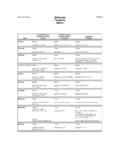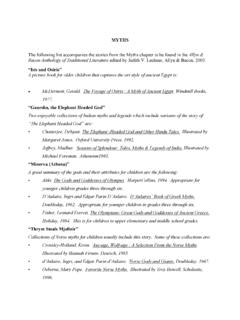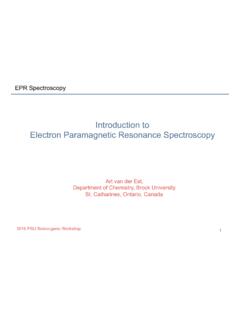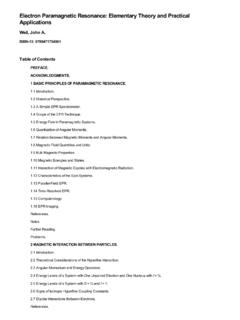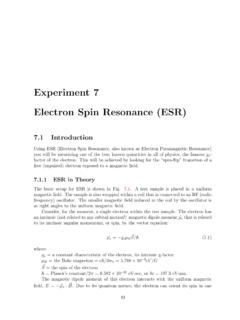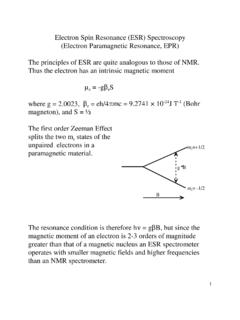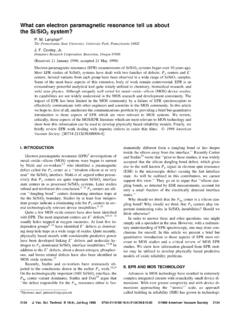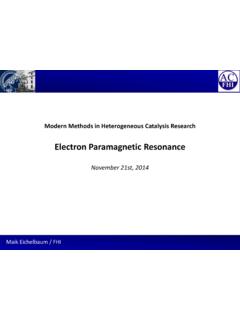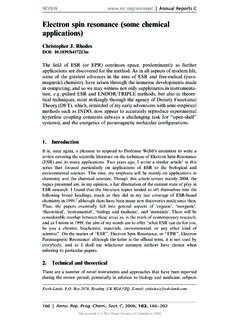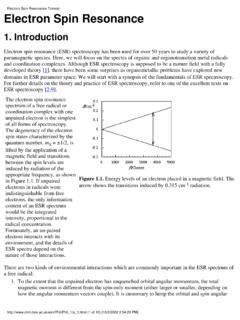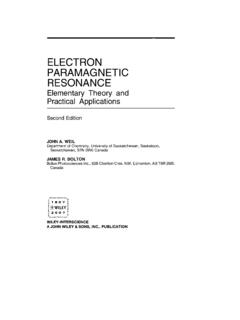Transcription of Wilfred R. Hagen Introduction to Biomolecular Electron ...
1 Wilfred R. Hagen Introduction to Paper: EPR spectroscopy as a probe of metal centres in Biomolecular biological systems (2006) Dalton Trans. 4415-4434. Electron Book: paramagnetic Biomolecular EPR Spectroscopy (2009). resonance theory Fred Hagen completed his PhD on EPR of metalloproteins at the University of Amsterdam in 1982 with Albracht Duin and Slater. 1 3. EPR, the Technique . Spectral Simulations Molecular EPR spectroscopy is a method to look at the The book Biomolecular EPR spectroscopy' comes with a structure and reactivity of molecules. suite of programs for basic manipulation and analysis of EPR. data which will be used in this class. EPR is limited to paramagnetic substances (unpaired electrons). When used in the study of metalloproteins not the whole molecule is observed but only that small part where the paramagnetism is located.
2 Isotropic Radicals This is usually the central place of action the active site of Single Integer Signal Simple Spectrum enzyme catalysis. Sensitivity: 10 M and up. Hyperfine Spectrum GeeStrain-5. Naming: Electron paramagnetic resonance (EPR), Electron Visual Rhombo spin resonance (ESR), Electron magnetic resonance (EMR) EPR File Converter EPR Editor 2 4. 1. Discovery A Free Electron in a Magnetic Field In 1944, Zavoisky discovered magnetic resonance . Actually it was EPR on CuCl2. An Electron with spin S = can have two orientations in a Zavoisky's first EPR system magnetic field B0 labeled by mS = + or mS = . The unpaired Electron will have a state of lowest energy when First EMR on the moment of the Electron is aligned with the magnetic field @ 133 MHz and a state of highest energy when aligned against the magnetic field. 5 7. EPR theory A Free Electron in a Magnetic Field A Free Electron in Vacuo The energy of each orientation is the product of and B0.
3 For an Electron = msge , where is a conversion constant called the Bohr magneton and ge is the spectroscopic g-factor of the free Electron and equals ( ). Free, unpaired Electron in space: Therefore, the energies for an Electron with ms = + and ms =. Electron spin - magnetic moment - are, respectively: ge B0 and - ge B0. 6 8. 2. A Free Electron in a Magnetic Field Spin-orbit Coupling The electronic-Zeeman energies are E = mSg B resonance condition: h = ge B0. When the Electron is bound to one, or more nuclei, then a virtual + : E = + ge B0 observer on the Electron would experience the nucleus (nuclei) as an orbiting positive charge producing a second magnetic field, B, at the Electron . - : E = - ge B0 h = ge (Be + B). Since only the spectrometer value of B is known: The Electron can change orientation by absorbing electromagnetic h = (ge + g) B = g B.
4 Radiation which energy should exactly The quantity g = ge + g contains the chemical information on the equal the state energy difference E, nature of the bond between the Electron and the molecule, the and this defines the resonance electronic structure of the molecule. condition: = = 0 The value of g can be taken as a fingerprint of the molecule. 9 11. A Free Electron in a Magnetic Field Anisotropy = 0. Two fundamental constants: - Planck's constant: h - Bohr magneton: . Two experimental parameters: Anisotropy: the fact that molecular properties, such as g are angular - Microwave frequency: dependent and reflect the 3D. - Magnetic field: B0 electronic structure of the paramagnet. A constant of proportionality: g-value Example: compound with axial paramagnetic anisotropy. This will Property of matter, for the free Electron : g = ge = have a different dg-value for different orientations dependent on the alignment of B0 along the z-axis or the y- or x-axes.
5 10 12. 3. Powder Spectrum Angular Dependency of g-Value A sample of realistic size Inclusion of the angular terms into the resonance equation consists of randomly oriented gives: molecules, resulting in a so- called powder spectrum. = , 0. In the example of the compound with axial paramagnetic A spin Hamiltonian that considers any arbitrary orientation anisotropy, the spectrum has of B relative to g is given by: axial EPR absorption. = . (Higher chance of having the B- vector anywhere in the xy-plane than parallel to the z-axis.). With being the Pauli spin operator vector with individual components , , and . 13 15. Angular Dependency of g-Value Angular Dependency of g-Value B can be aligned along any of the principle g tensor axes and the individual components of B are defined in terms of the polar angles ( , ). Bx = B sin cos , By = B sin sin , and Bz = B cos.
6 Filling in these values provides a more detailed matrix representation of the spin Hamiltonian equation: Defining the orientation of the magnetic field (a vector) with respect to the coordinates of the molecule (and vice versa). 0 0 . Two polar angles, and , where is the angle between the = 0 0 . vector B and the molecular z-axis, and is the angle between 0 0 . the projection of B onto the xy-plane and the x-axis.. 14 16. 4. Angular Dependency of g-Value Angular Dependency of g-Value Combining with the polar angles equations for the For resonance absorption to occur: individual components of B: 1 2 = = , 0. = ( + + ). As a result the value of g( , ) now becomes: The effect of the , , operators can be represented by the 2 2 Pauli spin matrices quantized in units of as: 2 2 2 + 2 2 2 + 2 2 . , = . 1 0 1 1 0 1 1 0. = , = , =. 2 1 0 2 0 2 0 1 This equation gives the effective anisotropic g value for any orientation ( , ) with respect to the applied magnetic field B.
7 17 19. Angular Dependency of g-Value Angular Dependency of g-Value 2 2 + 2 2 . The matrix of the Hamiltonian has the form: For axial spectra: = . 1 + . = . 2 . The two resulting eigenvalues are: 1 2 2 2 + 2 2 2 + 2 2 . 1 = . 2. 1 2 2 2 + 2 2 2 + 2 2 . 2 = . 2 Plot of the angle and the axial g-value versus the resonance field (gz = and gxy = , = 9500 MHz). 18 20. 5. Line Shape of EPR Spectra Correlation Between Line Shape and Structure EPR symmetry g and A tensors Molecular point symmetry Isotropic gxx = gyy = gzz Oh, Td, O, Th, T. Axx = Ayy = Azz Axial gxx = gyy gzz D4h, C4v, D4, D2d, D6h, Axx = Ayy Azz C6v, D6, D3h, D3d, C3v, D3. Rhombic gxx gyy gzz D2h, C2v, D2. Axx Ayy Azz Note: g// = gz and g = gxy 21 23. g-Value Correlation Between Line Shape and Structure Does the shape of the EPR signal, isotropic', axial', or = 0 rhombic' reflect the symmetry of a coordination site in a metalloprotein?
8 Two fundamental constants: Most of the time the answer is: No! - Planck's constant: h - Bohr magneton: . Example: the Cu(II) spectrum of plastocyanin is virtually axial (gx gy) even when recorded at higher frequency for For X-band: increased g-value resolution. ( ). = Crystallographic analysis, however, reveals a highly distorted ( ). tetrahedral site essentially with no symmetry at all! 22 24. 6. S=1/2 Systems Hyperfine Interactions + : E = + ge B0 Additional splitting can be observed in EPR. signals: Hyperfine interaction - : E = - ge B0 Interaction of the Electron spin with the nuclear spin of the metal ion nucleus Super hyperfine interaction Interaction of the Electron spin with first coordinate sphere ligands nuclei Spin-spin interaction resonance condition: For X-band: Interaction of the Electron spin with other ( ) Electron spins within 10 distance.
9 = = 0 = .. ( ). 25 27. What is this !?! Hyperfine Interactions Interaction of the Electron spin (S = ) with the nuclear spin of the metal ion nucleus (I = ). Four different situations: Four new energy levels 26 28. 7. Hyperfine Interactions Quantum Mechanical Description With the four new energy For an isolated system with a single unpaired Electron levels there are two field and no hyperfine interaction the only relevant interaction positions where the is the electronic Zeeman term, so the spin Hamiltonian is resonance conditions are = ( + + ). met: | ms| = 1, | mI| = 0. A shorter way of writing this is The signal is in principle split in two. = . Solving this we get the equation we saw earlier for the The original, unsplit, peak angular dependency of the g-value would have been exactly in the middle of the two , = 2 2 2 + 2 2 2 + 2 2 .. hyperfine lines.
10 29 31. Quantum Mechanical Description Quantum Mechanical Description A full quantum mechanical description of the More terms can be added to the Hamiltonian when spectroscopic EPR event is not possible due to the needed. complexity of the systems under study. For hyperfine interactions Hs becomes In Biomolecular EPR spectroscopy we use the concept = + . of the spin Hamiltonian. This describes a system with an extremely simplified form of the Schr dinger wave where A is the anisotropic hyperfine tensor. equation that is a valid description only of the lowest For multi- Electron (high-spin) systems Hs becomes electronic state of the molecule plus magnetic = + . interactions. where D is the zero-field interaction. = When both are present, both terms will have to be added! With: Hs, spin Hamiltonian; ys, the spin functions; E, energy values of the ground state spin manifold.







